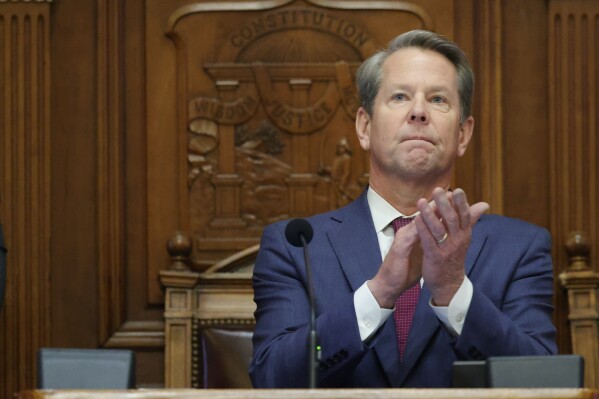Oregon Capitol construction quietly edges $90 million over budget
SALEM, Ore. (AP) — Oregon lawmakers this year quietly approved a $90 million cost overrun for a Capitol renovation project, ratcheting up spending by nearly 25% without public notice.
The new expenses found in budget bills passed late in the legislative session, were not mentioned in committee hearings or outlined in written testimony, Oregon Public Broadcasting reported on Tuesday.
The measures, expecting taxpayers to pay nearly $465 million for a $375 million job, were approved and voted on without discussion.
An official webpage describing the project was only changed to reflect the updated cost after OPB asked about it.
 Mississippi governor ignores low-budget challengers in GOP primary, focusing on Democrat in November
Mississippi governor ignores low-budget challengers in GOP primary, focusing on Democrat in November
 Governor signs Pennsylvania’s main budget, leaving work ahead for some programs’ funding
Governor signs Pennsylvania’s main budget, leaving work ahead for some programs’ funding
 Georgia Gov. Brian Kemp dangles the possibility of increased state spending after years of surpluses
Georgia Gov. Brian Kemp dangles the possibility of increased state spending after years of surpluses
The state’s top two lawmakers said explaining the cost overruns in public hearings wasn’t warranted. House Speaker Dan Rayfield’s office said the Capitol renovation received attention when it was OK’d last session and that even an increase approaching $100 million didn’t necessarily merit mention.
“Capital projects typically incur normal shifts in cost estimates, and so updates to the initial estimate were anticipated,” a spokesperson for Rayfield, D-Corvallis, said in an email.
Senate President Rob Wagner, D-Lake Oswego, in a statement said the increased spending followed their regular review procedure.
The two Democrats who control the budget-writing committee, along with two lawmakers who chair a subcommittee that approved the expenditure, didn’t respond to messages from the media outlet seeking comment.
Some Republicans, long wary about spending big on the Capitol, say the renovation project has been hard to track.
“We’ve been very frustrated with the lack of transparency,” said Senate Minority Leader Tim Knopp, R-Bend, a member of the budget committee. “Any tax dollar needs to have a conversation about why it’s being spent and how it’s being spent.”
Since 2016, lawmakers have sought to update the aging statehouse, paid for with tax revenues that have exceeded economist’s expectations.
The first two phases reworked outdated building systems, made entrances more accessible and took steps to seismically retrofit the building’s office wings.
Last year, lawmakers approved the third phase that updates the 1938 building that contains the House and Senate chambers and offices for the governor, state treasurer and secretary of state.
Beyond seismic and safety upgrades, including sprinkler systems, the third phase is slated to add four hearing rooms, offer a new café, and revamp work areas for journalists and lobbyists.
”We have a duty to complete it so that the result is a strong, sustainable building that maintains historical features, is safe for occupants, and allows regular legislative work to continue,” said Brett Hanes, the state’s legislative administrator charged with managing the Capitol.
Project managers say the reasons for the jump in costs are many. Documents submitted to state budget writers show inflation is more than $27 million of the $90 million increase.
The project has also grown in scope, Hanes said, with work to strengthen the Capitol’s distinct Art Deco dome, upgrade sound systems and replace elevator equipment.
Taxpayers also paid around $20 million so this year’s legislative session in the Capitol could be held with minimal interruption from the noisiest construction work.
Whether or not the noise abatement was worth $20 million is up for debate.
“If they were charging us not to make noise during hearings, that was an epic fail,” said Knopp. “People’s teeth were rattling. … While we were on the floor you literally had to scream into the microphone at times.”
Knopp also balked at holding this year’s session in a hearing room rather than the Senate chamber so work on the chamber could move forward more efficiently. That delayed the project by six months, project managers said.
”They obviously were working around us for most of the session,” said Knopp, who led his party on a six-week boycott this year for other reasons.
The lack of transparency appears to be built into a process for funding state construction projects that doesn’t demand that officials account for escalating costs. Budget writers knew about the hikes, and it wasn’t made part of the public record because no member of the budget committee asked for public explanation, staffers said.
“(Informational hearings) were held during the earlier phases of the project and the public is aware of its ongoing nature,” Hazel Tylinski, a spokesperson for Rayfield, said in an email. She added that top lawmakers and budget staffers “reviewed the cost estimate materials provided to ensure the project could complete construction.”
Benjamin Clark, a public policy professor at the University of Oregon who is an expert in public budgeting, said ideally these things would be put forward more transparently. But Clark also said he could make a case for Rayfield’s point.
”From the most generous of view … the people who put it there would say, ‘We’ve already approved it, we’re just trying to get it done,’” he said, adding: “There’s a normal operating procedure, and then there’s a more opaque version of that.”
The Legislature’s budget process, in which lawmakers make spending decisions, has drawn criticism in the past. Then-Rep. Marty Wilde, D-Eugene, complained last year that the budget was “a document entirely developed outside of the public view.”
“The Oregon Constitution requires the public’s business to be conducted publicly,” Wilde said at the time, “however inconvenient that might be.”
Disclaimer: The copyright of this article belongs to the original author. Reposting this article is solely for the purpose of information dissemination and does not constitute any investment advice. If there is any infringement, please contact us immediately. We will make corrections or deletions as necessary. Thank you.






